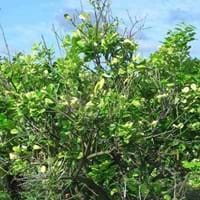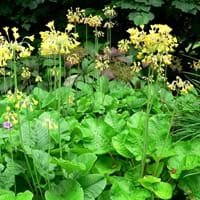Life Span
Perennial
Perennial
Origin
Southeastern Asia
Eastern Europe, Southern Europe, Russia/Siberia, Southern Asia, Western Asia
Types
Not Available
Not available
Habitat
Deep, gardens, old gardens, Well Drained
Roadsides, sand dunes, Waste areas
USDA Hardiness Zone
9-11
6-9
Sunset Zone
H1, H2, 8, 9, 12, 13, 14, 15, 16, 17, 18, 19, 20, 21, 22, 23, 24
1a, 1b, 2a, 2b, 3a, 3b, 4, 5, 6, 7, 8, 9, 14, 15, 16
Habit
Oval or Rounded
Oval or Rounded
Flower Color
White
Pink, Hot Pink, Rose
Flower Color Modifier
Bicolor
Bicolor
Fruit Color
Yellow, Green, Yellow green
Yellow, Yellow green, Pink, Dark Red
Leaf Color in Spring
Green
Green
Leaf Color in Summer
Green
Green
Leaf Color in Fall
Green
Green, Light Yellow, Brown
Leaf Color in Winter
Light Green
Light Green
Plant Season
Spring, Summer, Fall
Summer
Sunlight
Full Sun, Partial Sun
Full Sun, Partial Sun
Type of Soil
Loam, Sand
Loam, Sand
The pH of Soil
Acidic, Neutral
Acidic, Neutral, Alkaline
Soil Drainage
Well drained
Well drained
Bloom Time
Spring, Late Spring, Early Summer, Summer, Late Summer, Early Fall
Early Summer, Summer, Late Summer
Tolerances
Drought
Drought
Where to Plant?
Ground
Container, Ground, Pot
How to Plant?
Seedlings
Divison, Seedlings, Stem Planting
Plant Maintenance
Medium
Low
Watering Requirements
Average Water Needs, Water Deeply
Average Water Needs, Do Not over Water, Never Over-water, Requires regular watering, Water more in summer
In Summer
Lots of watering
Lots of watering
In Spring
Moderate
Moderate
In Winter
Average Water
Average Water
Soil pH
Acidic, Neutral
Acidic, Neutral
Soil Type
Loam, Sand
Loam, Sand
Soil Drainage Capacity
Well drained
Well drained
Sun Exposure
Full Sun, Partial Sun
Full Sun, Partial Sun, Partial shade
Pruning
Prune for shortening long shoots, Remove damaged leaves, Remove dead branches, Remove dead leaves, Thinning
Remove damaged leaves, Remove dead branches, Remove dead leaves
Fertilizers
Apply N-P-K, can go long without fertilizers
All-Purpose Liquid Fertilizer, fertilize in growing season
Pests and Diseases
Armored scales, Fomes root rot, Mites, Red blotch
Slugs, Snails
Plant Tolerance
Cold climate, Drought, Heat And Humidity
Variety of soil types
Flowers
Insignificant
Showy
Flower Petal Number
Single
Single
Fragrant Bark/Stem
Yes
No
Foliage Texture
Medium
Medium
Foliage Sheen
Glossy
Matte
Attracts
Birds, Butterflies
Not Available
Allergy
Not Available
Abdominal pain, Constipation, Diarrhea, Skin irritation
Aesthetic Uses
Bonsai
Beautification, Borders, Landscape Designing, Showy Purposes
Beauty Benefits
Not Available
Good for skin, Making cosmetics, Stops hair loss
Environmental Uses
Air purification
Air purification, Food for insects, Versatility
Medicinal Uses
Blood purifier, Digestion problems, Digestive disorders
Eczema
Part of Plant Used
Fruits, Leaves
Root
Other Uses
Making Shampoo, Used as insect repellent
Decoration Purposes, Medicinal oil, Showy Purposes, Used as Ornamental plant, Used for its medicinal properties
Used As Indoor Plant
No
Yes
Used As Outdoor Plant
Yes
Yes
Garden Design
Container, Edible, Fruit / Fruit Tree, Hedges, Mixed Border
Edging, Feature Plant, Groundcover, Mixed Border
Botanical Name
CITRUS hystrix
MALUS domestica 'Pink Pearl'
Common Name
Kaffir Lime, Makrut
Apple, Eating Apple, Pink Pearl Apple
In Hindi
काफ़िर लाइम
Tibetan cowslip
In German
Kaffernlimette
Tibet-Primel
In French
combava
Kauslip tibétain
In Spanish
cafre
Primula florindae
In Greek
Καφρός Lime
Primula florindae
In Portuguese
Kaffir Lime
cowslip tibetana
In Polish
kaffir wapno
tybetański cowslip
In Latin
Cafres Lime
Primula florindae
Phylum
Tracheophyta
Magnoliophyta
Class
Magnoliopsida
Magnoliopsida
Order
Sapindales
Myrtales
Family
Rutaceae
Onagraceae
Clade
Angiosperms, Eudicots, Rosids
Angiosperms, Eudicots, Rosids
Tribe
Not Available
Onagreae
Subfamily
Not Available
Onagroideae
Number of Species
Not Available
Importance of Kaffir Lime and Tibetan cowslip
Want to have the most appropriate plant for your garden? You might want to know the importance of Kaffir Lime and Tibetan cowslip. Basically, these two plants vary in many aspects. Compare Kaffir Lime and Tibetan cowslip as they differ in many characteristics such as their life, care, benefits, facts, etc. Every gardener must at least have the slightest clue about the plants he wants to plant in his garden. Compare their benefits, which differ in many ways like facts and uses. The medicinal use of Kaffir Lime is Blood purifier, Digestion problems and Digestive disorders whereas of Tibetan cowslip is Eczema. Kaffir Lime has beauty benefits as follows: Not Available while Tibetan cowslip has beauty benefits as follows: Not Available.
Compare Facts of Kaffir Lime vs Tibetan cowslip
How to choose the best garden plant for your garden depending upon its facts? Here garden plant comparison will help you to solve this query. Compare the facts of Kaffir Lime vs Tibetan cowslip and know which one to choose. As garden plants have benefits and other uses, allergy is also a major drawback of plants for some people. Allergic reactions of Kaffir Lime are Not Available whereas of Tibetan cowslip have Abdominal pain, Constipation, Diarrhea and Skin irritation respectively. Having a fruit bearing plant in your garden can be a plus point of your garden. Kaffir Lime has showy fruits and Tibetan cowslip has showy fruits. Also Kaffir Lime is not flowering and Tibetan cowslip is not flowering . You can compare Kaffir Lime and Tibetan cowslip facts and facts of other plants too.





